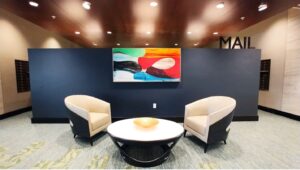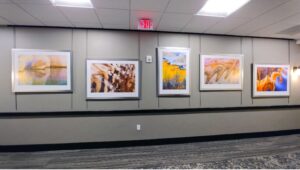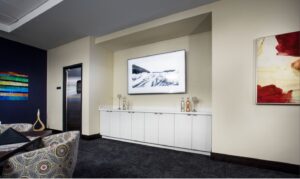
Sitting area utilizing abstract artwork. Cronin goes on to say, “interiors that celebrate the arts have the opportunity to engage residents and the community at-large in a whole new way.” He also sees the value in creating distinct amenities that offer a cultured lifestyle and work to enhance the resident lifestyle.
Track display system that allows for a rotating art program. Architectural Digest looked at this idea even further in their recent article, Designers Are Rethinking Senior Living – With a Focus on Wellness. Looking in particular at a new luxury building for seniors which had a specific focus of making its facility feel like home. The architectural team paid close attention to the aesthetic details while keeping unique user requirements at the forefront of design. In particular, they focused on color palettes, incorporating contrast to ease visual strain, patterns that positively affected depth perception, and comfortable furnishings.
Homelike environments that positively impact. These examples of designer’s selections put into practice, continue to echo the many opportunities for the physical environment to positively impact an individual’s needs. It becomes extremely important that artwork selected for each area, such as dining halls, communal areas, activity areas, on-property hair salons, etc., supports the needs of the community being served. Carefully selected artwork helps to create a place that encourages activities and relationships, allowing the communities to maximize capabilities, maintain as much independence as possible, and boost self-esteem.


